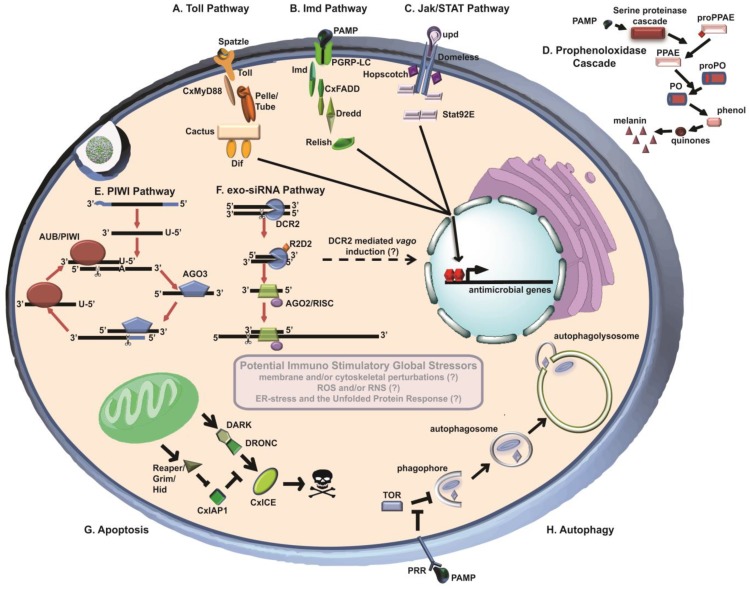Figure 1.
Mosquito innate immune pathways. (A) Toll-pathway signaling is initiated by Spӓtzle 5 binding to the Toll receptor, initiating the dissociation of Dif from Cactus. Dif translocates to the nucleus where it initiates transcription of antimicrobial genes; (B) Recognition of pathogen-associated molecular patterns (PAMPs) by peptidoglycan recognition protein-LC results in activation and translocation of Relish to the nucleus, and subsequent transcription of antimicrobial genes; (C) Extracellular unpaired (upd) binds to the transmembrane receptor Domeless, initiating dimerization of Stat92E, resulting in the subsequent transcription of antimicrobial genes. (D) The prophenoloxidase cascade is activated by PAMP activation of the serine proteinase cascade. The pro-prophenoloxidase activating enzyme (PPAE) peptide becomes activated upon cleavage by upstream serine proteinases, resulting in the activation of phenoloxidase. Phenoloxidase converts phenol to quinones, and eventually melanin; (E) The piRNA pathway may play a compensatory role to the exo-RNAi pathway during arbovirus infection. Primary piRNAs are fed into the “ping-pong dependent” amplification cycle, whereby cleavage of cognate mRNA leads to production of secondary piRNAs. These in turn bind to complementary transcripts, re-starting the cycle. (F) The exo-RNAi pathway is initiated by cellular recognition of exogenous dsRNA. DCR2 cleavage of long dsRNA results in 21nt siRNA duplexes, which are loaded into the RISC. Single-stranded guide strand siRNAs direct RISC to viral genomic RNA by sequence complementarity, leading to cleavage of the virus RNA by AGO2. The DExD/H-domain of DCR2 also leads to induction of the secreted peptide vago, activating Jak/STAT and leading to downstream activation of the virus-inducible gene vir-1, restricting virus replication. (G) Signaling by initiator caspases to effector caspases results in programmed cell death. H) Recognition of PAMPs by unknown PRRs inhibits TOR-mediated negative regulation of phagophore formation, leading to mature autophagosomes, which fuse to lysosomes leading to degradation of the contents of the autophagosomes.

